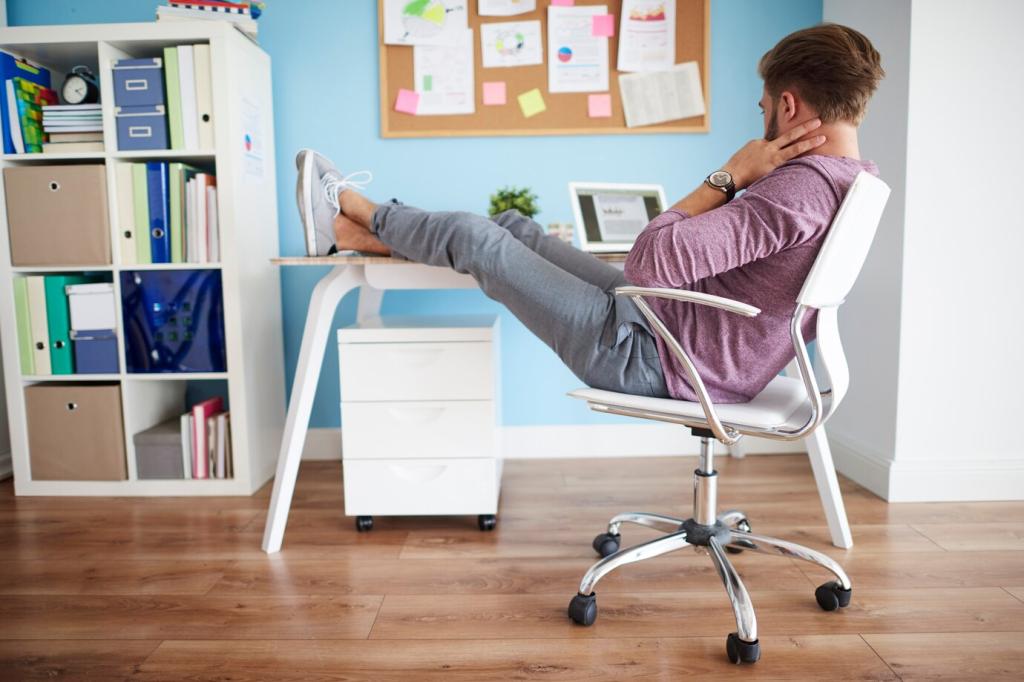Ergonomic Furniture Selection for Optimal Productivity
Selecting the right ergonomic furniture is a crucial step toward achieving optimal productivity and well-being in any workspace. The perfect blend of comfort, support, and design empowers individuals to maintain focus, reduce fatigue, and prevent injuries associated with prolonged sitting or incorrect posture. Understanding what makes furniture ergonomic and learning how to select appropriate pieces can transform not only your workspace but also your health and overall work output.

The Importance of Ergonomics in Workplace Design
Reducing Physical Strain
An ergonomically designed workspace focuses on minimizing physical stress on the body by supporting natural postures and reducing unnecessary reaching, bending, or twisting. Selecting chairs, desks, and accessories that adapt to the user’s dimensions ensures that muscles, ligaments, and joints are not overloaded over time. Consistent physical strain can lead to chronic pain, fatigue, and musculoskeletal disorders, ultimately affecting work output and long-term health. With proper furniture, these risks can be significantly decreased, enabling employees to perform at their best while staying healthy.


Enhancing Focus and Concentration
Comfortable and supportive furniture is directly linked to enhanced mental clarity and sustained focus during work hours. When individuals are not distracted by discomfort, pain, or awkward seating positions, they can devote their full attention to tasks. This mental ease creates a conducive environment for creativity, problem-solving, and high-level thinking, all of which are essential for a productive workday. This harmonious blend of physical and mental comfort is a key reason why ergonomics has become central to the modern workplace.
Fundamental Principles of Ergonomic Furniture

Adaptability and Adjustability
Furniture that offers multiple adjustment options empowers users to personalize their workstations according to their unique requirements. Adjustable chairs with customizable seat height, armrests, and back support allow for optimal alignment of the spine and limbs. Similarly, height-adjustable desks let users switch between sitting and standing positions, reducing sedentary time. This adaptability not only accommodates different body sizes but also enables each individual to find their most comfortable and effective working posture, leading to improved comfort and reduced risk of injury.

Proper Support and Alignment
The principle of support in ergonomic furniture revolves around maintaining the body’s natural alignment, particularly the spine’s curvature. Chairs with lumbar support, contoured seat cushions, and headrests ensure that users are not forced into unnatural positions that could cause strain. Desks and accessories, such as keyboard trays and monitor stands, promote proper positioning of the wrists, neck, and shoulders. This focus on alignment helps distribute body weight evenly, preventing muscle fatigue and chronic pain, especially during long work sessions.

Materials and Construction Quality
The longevity and comfort of ergonomic furniture depend heavily on the materials and craftsmanship used. Quality padding, breathable upholstery, and durable frames ensure that the furniture withstands daily use without losing its supportive properties. Investing in well-constructed ergonomic pieces not only guarantees lasting comfort but also reduces the need for frequent replacements, making it a prudent long-term choice. This commitment to quality assures that the furniture continues to deliver its intended health and productivity benefits over time.

Lumbar Support and Seat Design
The ergonomics of lumbar support and seat design are key in preventing lower back pain and ensuring a comfortable sitting experience. A well-designed chair will feature adjustable lumbar support that mirrors the natural curve of the spine, preventing slouching and promoting upright posture. The seat should be wide enough to allow free movement and include padding that is neither too soft nor too firm. Edge design—typically a waterfall edge—reduces pressure on the thighs, encouraging healthy circulation. Together, these features work in tandem to provide lasting support and reduce the risks of back pain or leg discomfort arising from prolonged sitting.

Adjustable Features for Personalization
The ability to personalize a chair for individual preferences and body types is a hallmark of ergonomic design. Adjustable components like armrests, seat height, tilt tension, and backrest recline enable users to tailor the chair to their specific workspace needs. By fine-tuning these elements, an individual can achieve optimal alignment of the knees, hips, and elbows relative to the desk, reducing strain and promoting a natural posture. This versatility ensures that whether you are typing, reading, or taking a call, the chair remains supportive and comfortable throughout various tasks.

Mobility and Stability
An ergonomic chair should also facilitate movement and stability, allowing users to access different work areas without strain. Smooth-rolling casters and a 360-degree swivel base make it easier to reach for files or collaborate with colleagues without unnecessary stretching. Stability is equally important—quality chairs feature strong bases and non-slip materials to maintain balance even during active movement. These characteristics combine to create a dynamic seating experience, enabling users to move naturally and stay engaged with their work while minimizing the risks of slips or falls.
Choosing an Ergonomic Desk for Productivity
Ideal Desk Height and Surface Area
Finding the right desk height is critical to maintaining proper body alignment while working. An ergonomic desk allows the user’s forearms to rest comfortably parallel to the ground, with elbows forming approximately a 90-degree angle. The surface area should be spacious enough to house essential work items, such as a computer, notebook, and accessories, without forcing the user to reach excessively. Proper desk dimensions also minimize visual clutter and make it easier to adopt a posture conducive to productivity, preventing strain on the shoulders, back, and eyes.
Sit-Stand Desks and Dynamic Working
Sit-stand desks have emerged as a popular ergonomic solution, allowing users to alternate between sitting and standing during the workday. This flexibility reduces the negative effects of prolonged sitting, such as stiffness or decreased circulation, while promoting movement and alertness. Many sit-stand desks are height-adjustable at the push of a button, ensuring a smooth transition and encouraging users to stay active. Integrating this type of desk into the workplace can significantly boost energy levels, creative thinking, and overall productivity by breaking up sedentary routines.
Organization and Cable Management
An organized workspace enhances efficiency, and an ergonomic desk should facilitate tidiness. Features like built-in cable management systems, drawers, and shelves help keep cords and papers out of sight, reducing visual distractions and making it easier to focus on tasks. Proper organization prevents accidents, such as tripping over tangled cords, and makes cleaning and maintenance simpler. A clutter-free environment is more inviting and contributes to a calmer, more productive mindset, ensuring that the workspace supports both aesthetics and usability.
Ergonomic Accessories and Workspace Enhancements
Monitor Positioning Solutions
Monitor arms and risers are essential accessories for achieving correct screen height and reducing neck and eye strain. By allowing easy adjustment of the monitor’s angle and position, these solutions ensure the top of the screen remains at or just below eye level, promoting a neutral neck posture. Correct placement reduces the likelihood of tension headaches and musculoskeletal discomfort, enabling longer periods of focused work. These accessories also free up valuable desk space, supporting an organized and uncluttered work surface that further enhances productivity.
Keyboard and Mouse Ergonomics
The configuration of your input devices is critical for preventing wrist and arm discomfort. Ergonomic keyboards and mice are designed to support the natural alignment of the wrists, reducing the risk of repetitive strain injuries, such as carpal tunnel syndrome. Adjustable keyboard trays allow users to position their devices at the ideal height and angle, ensuring a relaxed posture for hands and forearms. Making these small adjustments can have a significant impact on comfort, minimizing fatigue and enhancing typing speed and accuracy throughout the workday.
Footrests and Anti-Fatigue Devices
Footrests and anti-fatigue mats are highly effective ergonomic additions, especially for users who spend significant time sitting or standing. Footrests encourage users to shift their posture and alleviate pressure on the lower back by promoting healthy leg positioning. Anti-fatigue mats, typically used with standing desks, reduce the stress placed on feet, legs, and joints by providing cushioned support. These solutions help maintain overall comfort during long hours of work, prevent stagnation, and support productive movement throughout the day.
Creating an Ergonomic Home Office
Space limitations at home often call for multi-functional ergonomic furniture, which offers flexibility and efficiency without sacrificing comfort. Pieces like convertible desks, foldable chairs, and adaptable storage solutions make the most of small or shared spaces while supporting healthy posture and easy workflow transitions. Multi-functionality also allows for a quick reconfiguration of the workspace as needs change, ensuring that the home office remains practical and ergonomic, even as tasks or priorities evolve.

People come in all shapes and sizes, so ergonomic furniture must offer the flexibility to cater to this diversity. Selecting chairs with adjustable seat depth and backrest height, as well as desks with broad height ranges, ensures that both tall and petite individuals can work comfortably. Additionally, accessories like footrests can help shorter users achieve proper alignment, while ergonomic keyboards and monitors can be positioned to accommodate differences in arm length or vision. This attention to detail guarantees that everyone enjoys a personalized and health-protective experience, further promoting productivity.
Customizing Ergonomics for Different Users
Long-Term Benefits and Investment Value of Ergonomic Furniture
Health Maintenance and Injury Prevention
The primary long-term advantage of ergonomic furniture is its role in preserving health and preventing workplace injuries. Prolonged exposure to non-ergonomic setups can lead to chronic pain, musculoskeletal disorders, tension headaches, and even circulation problems. By equipping spaces with supportive and adjustable furniture, these risks are dramatically reduced. Investing in ergonomics represents a proactive approach to health maintenance, potentially lowering medical costs and minimizing time lost to illness or injury.
Productivity Gains and Employee Satisfaction
Ergonomic furniture fosters higher productivity by minimizing discomfort and boosting morale. Employees who work comfortably are more likely to focus, collaborate, and innovate effectively. Organizations that prioritize ergonomics report reduced absenteeism, increased job satisfaction, and improved staff retention. The sense that employers care for their wellbeing enhances engagement and loyalty, directly impacting performance in both the short and long term.
Financial Savings and Sustainability
While the initial investment in ergonomic furniture may seem substantial, the long-term financial savings are significant. Reduced rates of injury and sickness lead to lower insurance costs, less absenteeism, and minimal expenditures on sick leave or workers’ compensation. Additionally, durable, well-constructed ergonomic products have a longer lifespan, reducing replacement frequency and environmental waste. This approach not only promotes fiscal responsibility but also supports broader sustainability initiatives, making it a prudent and ethical choice for any workplace.
